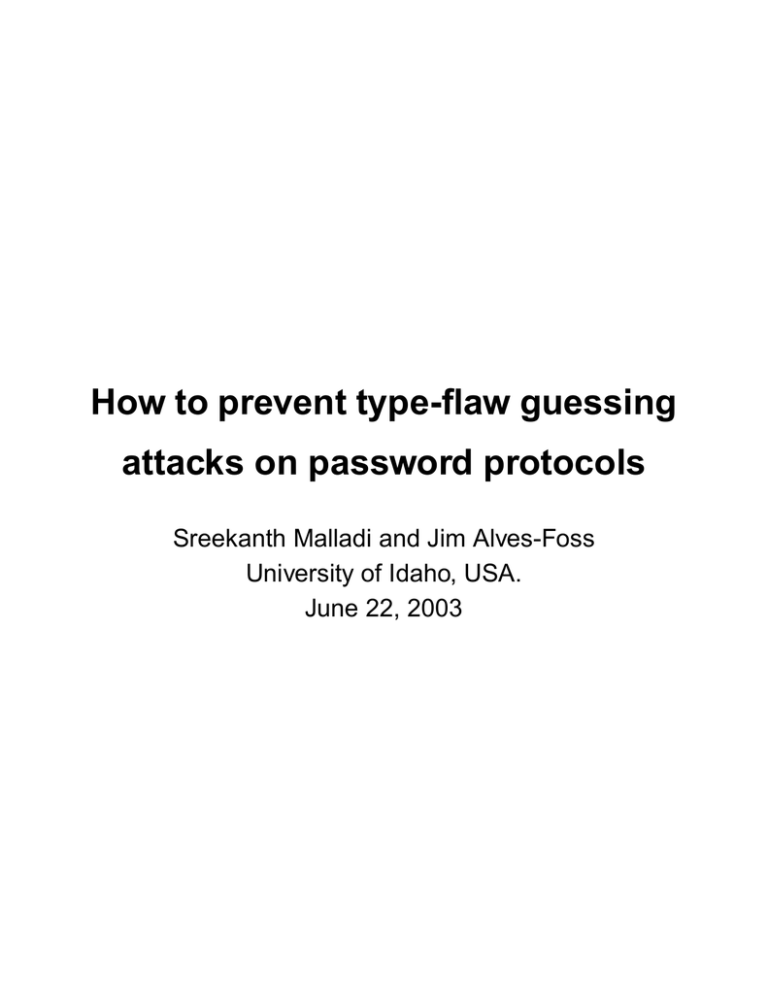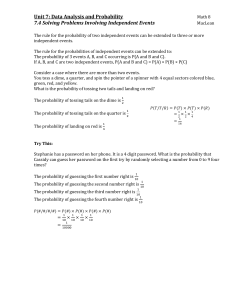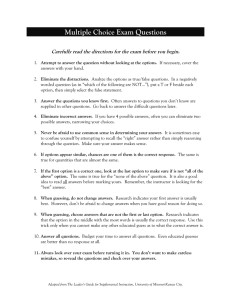How to prevent type-flaw guessing attacks on password protocols
advertisement

How to prevent type-flaw guessing
attacks on password protocols
Sreekanth Malladi and Jim Alves-Foss
University of Idaho, USA.
June 22, 2003
Password protocols
Protocols using passwords for authentication and key
establishment.
Guessing attacks: Introduction
na
{na}passwd(a,b)
Guesses: monday, tuesday, wednesday, ...
{na}monday
{na}tuesday
{na}wednesday . . .
1
Type-flaws
Data of one type, later interpreted as different type.
Examples: na as ka, {nb, a}k as na etc.
Type-glaw guessing attacks
Guessing attacks using type-flaws. i.e.
1. Induce type-flaws in on-line communication;
2. Verify a guess off-line using the messages.
2
Continued ...
Example:
P1 (Lomas et al.’s protocol [GLNS93]):
Msg 1. A → B : {C, N }pk(B)
Msg 2. B → A : {f (N )}P AB .
C - confounder, N - integer, f - invertible function,
P AB - passwd(A, B).
P2:
Msg 1. A → B : {N, C}pk(B)
Msg 2. B → A : {f (N )}P AB .
3
P1 and P2 are combined:
On-line phase:
Msg P1.1.
Msg P1.2.
Msg P2.1.
Msg P2.2.
a → b : {c, n}pk(b)
b → a : {f (n)}pab
I(a) → b : {c, n}pk(b)
b → I(a) : {f (c)}pab.
Off-line phase:
guess pab ,
decrypt {f (n)}pab, {f (c)}pab
encrypt (c, n) with pk(b)
verify.
4
Heather et al.’s solution:
• Tag each field with it’s type;
• eg. na as (nonce, na);
• Problem when used in password protocols: Tags
verify guess directly!!
• eg. {na}passwd(a,b) as {nonce, na}passwd(a,b);
• Decrypt with guess, check for “nonce”;
• If found, verifies the guess rightaway!!
• Conclusion: Heather et al.’s solution cannot be
used in password protocols.
5
Hypothesis:
Avoiding tags inside password encryptions prevent most type-flaw guessing attacks.
Proof Strategy:
Aim:
Protocol is secure without type-flaws ⇒ Protocol secure under tagging
Therefore, prove that
Attack on tagging scheme ⇒ Attack when all
fields correctly tagged.
6
Proof parts
1. On-line communication;
2. Off-line guessing and verification.
Part 1:
Using Heather et al.’s results in [HLS00].
Part 2:
Using our def of guessing attacks [CMAE03].
7
Protocol model
• Based on Heather et al.’s [HLS00];
• Message structure – Tags, Facts and Taggedfacts.
• Tags – agent, nonce, . . . ;
• Facts – Atom, Pairs, Encryptions;
• TaggedFacts – (tag,fact);
• Well-tagged fact – Tag is indeed the type of the
fact.
8
Protocol model – Continued ...
• Our change: Treat password encryptions as subset of Atoms;
• i.e. Password encryptions as an “abstract type”;
• Possible because we disallow attacker operations
on them;
• Do not consider password learnt by breaching secrecy;.
9
• Framework – Strand spaces
1. Strands – Communications of honest agent or
penetrator;
2. Bundle – Partial or complete protocol run.
• Honest strands – Modelled using “strand templates”;
• Strand templates output honest strands after instantiation.
• Penetrator strands – Dolev-Yao attacker with standard inference rules.
10
Transforming arbitrarily tagged bundles to welltagged bundles
• Define a renaming function φ;
• φ changes an aribtrary bundle C to a well-tagged
bundle;
• Possible because, if honest agent accepts ill-tagged
fact, it should accept any value in it’s place;
• Show if s is an honest strand, so is φ(s) (from
[HLS00,Lemma 3.2]);
• Show if s is a penetrator strand, so is φ(s) (from
[HLS00,section 3.3]).
11
Part 1: Results in [HLS00,Theorem 1]
If C is a bundle (under the tagging scheme) then there
00
is a renaming function φ and a bundle C , such that:
00
• C contains the tagged facts of C (considered as
a set), renamed by φ;
00
• C contains the same honest strands as C, modulo some renaming;
00
• facts are uniquely originating in C if they were
uniquely originating in C;
00
• all tagged facts in C are well-tagged.
12
Part 2: Guessing attacks
Off-line attacker capabilities:
• Use a guess to encrypt and decrypt password encryptions;
• Split and concatenate facts;
• Tag facts and untag taggedfacts.
• Given bundle C and taggedfact tf ;
– Define |= on C and tf such that C |= tf if,
– There exist a valid sequence of attacker actions to produce tf from C;
13
Defining guessing attacks
• Attacker must synthesize a term in two ways using a guess;
• But in atmost one way without using the guess;
Formally,
Definition 1. g is verifiable from C and tf is a verifier
for g iff:
ˆ ; and
1. Ĉ ∪ {g} |= tf ∧ Ĉ ∪ {g} |= tf
ˆ.
2. Ĉ 6|= tf ∨ Ĉ 6|= tf
ˆ is a fresh constant and Ĉ is obtained by rewhere tf
ˆ.
placing the particular occurrence of tf in C, with tf
14
Lemma 1.
00
C ∪ {g} |=tr tf ⇒ C ∪ {g} |=φ(tr) φ(tf ).
i.e attacker can derive a term from C 00 if the corresponding term is derivable from C.
Corollary 1.
00
C 6|= tf ⇒ C 6|= φ(tf ).
i.e. attacker cannot derive a term from C 00 if the corresponding term is not derivable from C.
15
Main result
• Let C 00 be denoted as C.
• If guessing attack on C, then,
ˆ ; and
1. Ĉ ∪ {g} |= tf ∧ Ĉ ∪ {g} |= tf
ˆ.
2. Ĉ 6|= tf ∨ Ĉ 6|= tf
• Rewrite above expressions,
ˆ 0; and
10. Cˆ ∪ {g} |= tf 0 ∧ Cˆ ∪ {g} |= tf
ˆ 0.
20. Cˆ |6 = tf 0 ∨ Cˆ 6|= tf
• Possible because of Lemma 1 and Corollary 1;
• Therefore, attack on C ⇒ attack on C 00.
16
Conclusion
1. Type-flaws can be used to launch guessing attacks;
2. Most of them can be prevented by type-tagging;
3. Proof consisted of two parts;
4. Similar on-line communication is possible on two
protocol runs with and without type-flaws;
5. Above point follows from Heather et al.’s results;
6. Corresponding guessing attack on both or on none;
7. Indirectly proves attack not due to type-flaws.
17
Future work
1. Limitation: replaying {t1}passwd(a,b) in {t2}passwd(a,b).
2. Tagging can be simplified – just use component
numbers inside encryptions;
3. Proving “protocol-ids” inside strong encryptions
prevent multi-protocol guessing attacks;
4. Effects of the solutions on secrecy and authentication;
5. Effects when using non-standard inference rules;
6. Decidability of guessing attacks (tagging helps);
18
7. Limitations of Heather et al.’s and our proofs:
(a) Do not consider all possible constructed keys
(only sequence of atoms);
(b) Message elements without algebraice properties (eg. XOR and products);
(c) Above two required for “real-world” protocols.
Acknowledgments
Paper dedicated to Late Professor Roger Needham.
Thanks to
1. Iliano Cervesato;
2. Anonymous referees;
3. Ricardo Corin;
4. Vitaly Shmatikov; and
YOU ALL !!!
19
Bibliography
CMAE03 R. Corin, S. Malladi, J. Alves-Foss and S. Etalle.
Guess what? Here is a new tool that finds some
new guessing attacks. Workshop on Issues in
the Theory of Security (WITS’03), Warsaw, March
2003.
GLNS93 L. Gong, T. M. Lomas, R. M. Needham, and J. H.
Saltzer. Protecting poorly chosen secrets from
guessing attacks. IEEE Journal on Selected Areas in Communications, 11(5):648–656, 1993.
HLS00 J. Heather, G. Lowe, and S. Schneider. How to
prevent type flaw attacks on security protocols.
In Proceedings, 13th Computer Security Foundations Workshop, 255-268, , July 2000.
20





